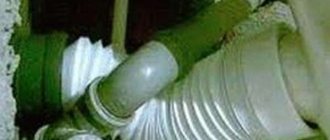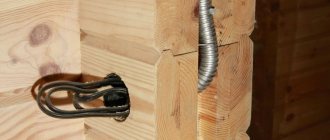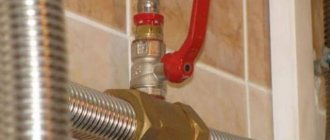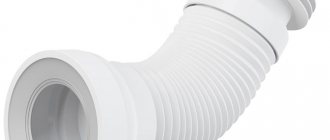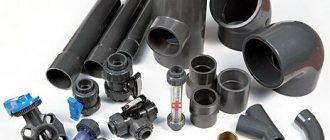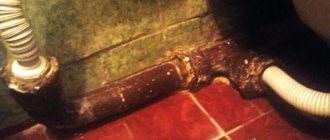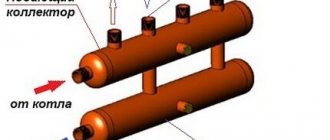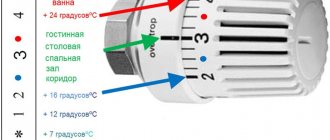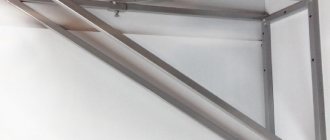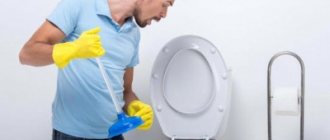- What is corrugation?
- Types of corrugations for toilet bowls
- How to make the right choice
- How to easily remove the old corrugation?
- Installation rules in case of corrugation replacement
- Installation process
- In what case is it necessary to install corrugation?
Not so long ago, sewer lines consisted mainly of cast iron parts. Cast iron pipes were connected to the toilet, which were considered very reliable and durable. However, in reality it turned out that such pipes were practically overgrown and clogged with dirt, which made their further operation impossible. Thus, progress has gradually reached modern high-tech materials such as corrugation. But even the newest types of materials need to be replaced over time. Thus, the average person is faced with a new problem - replacing the corrugation on the toilet. Let's look at how to make it yourself.
What is corrugation?
The designs of toilets and pipe fittings were constantly changing. Consequently, it was necessary to adapt to more and more new design solutions. To this end, manufacturers began to produce new high-strength thermoplastic products. Thus, corrugation has firmly entered into everyday life and has become a necessary and important part of the toilet design. It is this that serves as the transitional element that connects the toilet and sewer system.
Simple corrugated pipe
The direct responsibility of the corrugated pipe is to drain wastewater into the riser, from where it will enter the sewer system. A distinctive feature of corrugation is its flexibility and ductility. The corrugated pipe can be easily stretched. It is clear that such properties made it much easier and faster to install and connect the toilet to the system.
All this became possible thanks to the materials from which not only the corrugated pipe itself is made, but also the fastening auxiliary parts for it. Let's figure out which corrugation is suitable for use in toilets and how to change it if necessary.
Threaded connection
This is an equally reliable way to replace a damaged part without welding. The preparation is the same as when using clamps, but fastening is done differently. Replacement is carried out in the following sequence:
- A new corrugation is installed.
- 6 - 8 through holes (depending on its diameter) with a diameter of 4.2 mm are drilled in the pipe placed on the exhaust pipe. They should be evenly spaced around the circumference.
- Threads are cut into the holes on the pipe using an M5 tap, and the pipe is drilled out to a diameter of slightly more than 5 mm.
- After lubricating the bolts and holes with sealant, one end of the corrugation is secured in place using engraving washers.
- Without securing the second end, the structure is assembled and installed on the car. The line for placing the edge of the pipe is marked to avoid skewing.
- After removal, holes are drilled and the second pipe is attached.
- After final assembly, a test drive is made.
Fastening the corrugation with bolts - the finished result
Replacing electric welding with a threaded connection allows you to do without going to a service station. The quality of the repair does not suffer, since the corrugation successfully withstands longitudinal and transverse impacts.
Types of corrugations for toilet bowls
Corrugation is a tube with a corrugated surface. At one end there is a pipe that connects the toilet to the sewer, and at the other there is a ring-shaped pipe with a Christmas tree-shaped rubber band that serves as a seal.
Most often on the market you can find corrugated pipes made of two materials:
- Rubber;
- Plastic.
Depending on what material the corrugation you purchased is made of, you can judge its properties. However, the peculiarity is that it can stretch up to almost 1 m in length, and also bend anywhere you need it. This allows you to place plumbing fixtures at any end of the bathroom, wherever you want.
So, what types of corrugated pipes exist:
Reinforced corrugation
- Reinforced is quite rigid, so when choosing it, you need to take into account the structural features of the toilet. It contains wire, which gives rigidity to its walls. This type of product will cost slightly more than others where wire is not used, but it will also last longer.
- Mixed - suitable for non-standard toilet installations. For example, if the designer decides that the toilet should lag behind the wall by a certain distance.
- Drain is the most versatile option among all. With the help of such a corrugation, the toilet can be connected both to a plastic pipeline and to an outdated one, stuffed with various shaped cast iron parts. It is mainly used by those who do not want to think about how suitable the corrugation is to the chosen model of plumbing fixtures.
In this case, it cannot be said that any type of corrugation is better or worse. It’s just that each type is suitable in some specific case. But be that as it may, when purchasing, you need to ensure that the product has a dense structure and is free from defects.
Rules
Flexible and hygienic designs are very easy to install. However, when working with modern products, do not forget to follow certain rules. But first, you should understand the design of the drain slope in the toilet, which you decided to connect to the sewer system.
The release angle can be:
- straight;
- oblique;
- vertical.
In the first two cases, installing a flexible connecting hose will not be difficult. However, with a vertical slope, its installation becomes impossible. In this case, the neck of the toilet must be firmly connected to the vertical drain system.
In the photo - a plastic corrugated plumbing hose
If a higher level of connection is installed, it will not be possible to establish free drainage of the liquid. Therefore, today we will not consider independent connection of a vertical outlet. In other cases, replacing the corrugation on a toilet can be done even without the necessary qualifications and training.
When should you change the corrugation?
Most often this happens in two cases:
| Axial displacement | For some reason, the installation of the toilet occurs with an axial displacement relative to the sewer socket. For example, this can happen when tiles were laid on top of the old ones during renovation, which caused the toilet to rise. |
| Toilet outlet not suitable | In this case, when purchasing a new toilet, they did not take into account the type of drain outlet. For example, a purchased imported plumbing fixture has a horizontal outlet, but it must be installed in a typical Soviet-built apartment, in which the sewer system is designed for an oblique outlet. |
Advice: when renovations in a house or apartment include replacing the sewer system, it is immediately better to install pipes for a certain type of toilet outlet.
What are the possible disadvantages of corrugation?
- A thin wall that can be easily damaged from the outside and inside, for example, by accidentally flushing a shard of glass down the toilet . For all its resistance to aggressive environments, any plastic has a limit of strength and therefore gradually becomes unusable under their influence. The thinner the wall, the faster this will happen.
- Bathroom aesthetics . The corrugated plastic sleeve does not look as neat and beautiful as the pipe leading to the toilet outlet. Also, deposits inside can be visible through its walls.
- Inevitable sagging of the corrugation when the distance from the toilet outlet to the sewer socket is large . Due to the unevenness of the walls, deposits will remain, which will definitely pull it down. After this, water will begin to accumulate in the sagging area.
Before you put the corrugation on the toilet, you need to clean its outlet
How to choose quality products
Understanding the principle of corrugation selection, you will be able to purchase the best product for the work:
- A wide range of prices should not confuse the consumer when choosing the right plumbing elements. Also, when choosing corrugation, you need to pay attention to the highest quality product.
- The price of such connecting plastic products is low. Therefore, with insignificant savings, the consumer risks buying a product that is not of very high quality, which will subsequently complicate the operation of the plumbing fixture and shorten its service life.
Advice: unfortunately, our companies cannot yet compare in quality with foreign ones, so we recommend purchasing imported products.
- When choosing, also give preference to corrugation reinforced with metal wire or mesh. Such a product will be able to retain its original strength longer.
Use silicone sealant for the toilet bowl
- Determine in advance the distance from the toilet outlet to the socket of the sewer system, then the elastic partition will not sag or stretch excessively.
- Choose products with thick and hard walls, then they will perform their function longer.
- The durability of the product is also affected by the thickness and rigidity of the pipe walls.
Installation of plastic corrugation
Below are step-by-step instructions with recommendations that will help you do the repair yourself:
- Disconnect the toilet tank from the water supply if the installation will be carried out on plumbing already installed in the bathroom.
- Thoroughly clean the outlet of old sealant, cement putty, mucus and dirt.
Tip: strongly dried cement can be easily knocked off with a chisel. Do not leave even the slightest deposits, as this will negatively affect the seal.
- Apply a layer of sealant to the outside of the outlet. When you put the pipe on, it will tightly fit around the neck of the plumbing fixture and the silicone will disappear inside the connection.
- Place the corrugation onto the outlet with the wide end, over the edge, extending at least 50 mm. Straighten it in a circular motion, then you can avoid distortions between the inner membrane and the accordion of the wall.
Tip: if the corrugation is excessively dense, its installation may be difficult. Then use force when pressing.
- Wait for the sealant to dry.
- Install the toilet in a permanent place, carefully adjust the location of the components. Secure it with the mounting screws.
- Insert the seal all the way into the drain hole. Apply sealant to the inside of it.
- Check the tightness of the structure by pouring 10-12 liters of water into the toilet. The outer part of the corrugation should remain dry.
Before removing the corrugation from the toilet, the latter can be dismantled and then put back in place
We replace corrugations
It will have to be changed from time to time; the reasons may vary. This is not difficult to do, even when the toilet is slightly offset relative to the sewer outlet.
You need to know the exact size of the adapter:
- short;
- average;
- long.
This will affect the installation and its service life.
How to replace corrugations on a toilet
So, how to change the corrugation on the toilet:
- thoroughly clean the plumbing parts from the previously applied layer of sealant, which will guarantee quality in the future;
- Insert one edge of the pipe into the neck of the toilet until it stops;
- place the other end on the outlet of the drain system;
- Check the tightness of the connections by pouring a large amount of water.
Now you know how to replace the corrugation on the toilet if the service life of the old equipment has expired or a sewer leak has occurred. Even a person without experience in such work can change a plastic corrugated sleeve.
How to make the right choice
In the store, when you select corrugation, pay attention to the characteristics. They are usually contained in the product instructions. Characteristics include parameters such as length, seal type, bore diameter and much more.
Diameter of plastic pipe for toilet
The diameter of the corrugated pipe may also vary. Therefore, before purchasing it, measure the diameter of the pipe where it will be attached to the toilet. Of course, the ideal option is to purchase a toilet and corrugation together. Then the option of incorrectly selecting the diameter of the corrugated pipe is completely excluded.
What else is used to connect the toilet to the sewer if the corrugation is not suitable for one reason or another:
- The coupling is used if the toilet outlet is located in close proximity to the sewer.
- A plastic outlet is suitable if the entrance to the sewer system is located on the side and at a short distance.
A soft or hard corrugated pipe is used when the sewer hole is located directly opposite the toilet, but there are any obstacles in the way. The second option is to rotate the toilet at the desired angle.
When choosing, you should also give preference to corrugation from a reliable manufacturer. You should not save on it, otherwise frequent repairs and replacements will haunt you. The material from which the budget version of corrugation is made dries out too quickly and becomes brittle.
Installation step by step
Let's look at the procedure for connecting a toilet using corrugation. This work is quite simple, but there is no need to disrupt the procedure. It is advisable to install the corrugation when the toilet is not yet connected in place. It is more comfortable. But if you install corrugation on an old toilet, you will have to prepare it:
- remove old cement;
- remove sealant (if present);
- clean the sewer pipe socket.
Otherwise, the tightness of the connection will be in question. Some people use sealant when installing corrugations. However, experts do not recommend using a cheap one, as it may break down over time.
So we bought a toilet. What's next? Further work is carried out step by step.
- The end of the pipe that will be connected to the sewer is treated with silicone. The end of the outlet is evenly blocked by a branch of 5-6 centimeters.
- The tension is carried out without distortions, as evenly as possible.
- To make tightening easier, lubricate the rubber seal on the socket with soap.
- The corrugated pipe is installed in the inlet with one end, and the other is mounted to the toilet.
- Pouring water into the toilet.
- Check joints for leaks.
- The toilet mounting points are marked on the floor. The corrugation is first disconnected.
- The holes are drilled and coated with sealant.
- The toilet is fixed to the floor. The fastening bolts are tightened until the structure stops wobbling and is perpendicular to the floor.
- Then the adapter is reconnected.
- The joints are treated with plumbing sealant.
- The screed is poured.
- The floor surface is being finished.
How to easily remove the old corrugation?
Installation of a toilet with corrugation
So, you have a problem when you need to remove the old corrugation and replace it with a new one. What do you need to do for this and where to start? The process of removing the old corrugation will be easier if:
- The installed corrugated pipe is stretched to its maximum. In this case, it is quite easy to remove it from the toilet pipe and then from the sewer pipe. At the same time, the remaining water can be easily removed from the pipe by draining it into the sewer.
- If the toilet occupies a corner position, then the arc rule will have to be applied here. In this case, the corrugation is also easily removed from both pipes. In this case, you first need to remove it from the toilet pipe.
- It happens that the corrugated pipe is not stretched at all due to the fact that the toilet is too close to the wastewater drain. Here, to make it easier to remove the corrugation, you will have to remove the toilet itself from its mountings. The corrugation will be removed in the same sequence as in the previous version.
Next, you can install a new corrugation, which is done in the reverse order.
Repair and connection methods
Installation procedure
Experts give advice on how to change the corrugation on a toilet. There are two connection methods for this. The first is used in cases of moving the location of the device or to change its rotation. But if you want to install the device end-to-end in order to ergonomically use a small space, then the plastic pipe will prevent you from doing this.
Therefore, you need to determine in advance the required length of the soft corrugated product, since a long pipe will bend and prevent drainage into the sewer and cause blockages, and installing a short element will lead to its stretching and loss of strength.
Another method is to use a rigid corrugation, which provides maximum reliability when connecting a toilet with a horizontal or oblique outlet.
Installation rules in case of corrugation replacement
Nowadays, almost all plumbers prefer to work with corrugation. Installing it is convenient and quick. Any problems associated with it mainly come down to leakage due to wear and tear of the product. This occurs at the end of its service life.
If you decide to do it yourself and make the replacement yourself, then it’s good if you already had some plumbing experience. Then replacing the corrugation will not be difficult for you.
Installing the corrugation is usually not difficult. One end of it is inserted into the sewer pipe, and the other is pulled over the outlet by about five centimeters. Don’t be afraid that it will tear; even the shortest corrugation can stretch to the required minimum.
To ensure that the joints do not allow air or water to pass through, they must be treated with a sealant. It is necessary to treat the sewer bell only after it has been washed and before the corrugation is installed in place.
Tools needed to replace the part yourself
To perform installation work you should prepare :
- additional fasteners that prevent sagging of the corrugation (for short and slightly stretched connections will not be needed );
- plumbing sealant - silicone sealant - for lubricating mating surfaces ;
- a knife or similar tool for cleaning the pipes from dirt ;
- rags.
Photo 1. SantekhMasterGel plumbing sealant for sealing threaded connections.
To install the corrugation, no special devices are required , so you only have to buy sealant; the rest can be found in the house.
Installation process
The corrugated pipe installation process goes through the following points:
- The toilet pipe is thoroughly cleaned of any remaining seals and connections that were in it before. They do roughly the same thing with the sewer drain pipe. It happens that old connections are sealed with concrete, then you will have to knock them down with a hammer and chisel.
- The joints are wiped dry so that there are no stains of grease or dust left there. It is necessary to ensure that no traces of sealants or other products from the previous installation remain on the pipes.
- First, the corrugation is inserted into the toilet, moved towards the drain and the other end inserted into it.
- It is best that the corrugation is not too tight. This will increase its service life.
- Finally, the toilet is screwed to the floor.
Damage Prevention
Due to the high causticity of such products, it is necessary to observe safety precautions when working with them.
To increase the service life of a corrugated pipe, the following preventive rules must be observed:
- protect plumbing from exposure to high temperatures;
- periodically clean pipes from dirt and deposits;
- do not use potent products that contain highly concentrated acids;
- avoid mechanical damage.
A leak in the toilet, and in particular in the pipes through which it is connected to communications, is a rather unpleasant situation. However, in order to minimize the risk of its occurrence, it is necessary to pay attention to the correct installation of the corrugation, use suitable high-quality material, and follow preventive rules that reduce the likelihood of wear on the structure.
- Author: Natalya32
Rate this article: (3 votes, average: 5 out of 5)
In what case is it necessary to install corrugation?
When does installing corrugation become an integral part of plumbing work in your own bathroom? Corrugation is absolutely necessary in two cases:
- The toilet is installed offset to one side or at an angle to the entire bathroom. This may be necessary when the floor is raised to a certain level, or a new device is installed, such as a washing machine. Then the toilet in its previous position may be inconvenient to use, and it will need to be moved or slightly shifted.
- You accidentally purchased a toilet with a larger or smaller diameter than the corrugation itself. This often happens when they buy an imported toilet and its entrance is straight, but the sewer hole, on the contrary, is intended for oblique installation.
Thus, replacing the toilet bowl corrugation with your own hands will not cause us any difficulties if you know its features and worry about the right choice in a plumbing store.
Common causes of corrugation failure
Ideally, the corrugation should be installed at a slight angle. Various reasons lead to corrugation failure, including:
- absence or damage to the sealing ring in the socket;
- low quality adapter;
- absence or wear of the transition cuff;
- The corrugation is too inclined.
Depending on the cause of damage to the element, the appropriate method of repairing it is selected.
Forms of release in the drain system
You can change the location of the bell, but you should remember that this will take up some space. And, as you know, many rooms of this type are very small in area. If you change the location of the drain in a small room, there will be very little free space left. This is especially true for toilets that are combined with a bathroom. To do this, it is not necessary to call specialists, since you can replace the drain mold yourself.
First you need to note the release forms, there are only three of them:
- Horizontal;
- Oblique;
- Vertical.
Toilet with direct release
The horizontal release came to us from Europe. Sealing here is complicated, and there are no special advantages. It can allow you to place the toilet as close to the riser as possible. It is precisely because of this single advantage that buyers choose toilets with this particular form of release. More often, these are those buyers whose toilet space is very small, and this type of toilet can save some space, leaving more free space than other types of toilets.
Toilets with an oblique release form are the most popular type of plumbing fixtures. It should be noted that a toilet with a horizontal outlet can be easily connected to an inclined socket. There are corrugations specifically for this purpose.
The vertical type of drain is ideal for those houses in which the sewer pipe runs above the ceiling of the lower apartment.
As a rule, here you cannot choose the form of release that you like. Toilets are selected based on the location of the sewer pipe and the socket that goes into it. If it is located under the floor, then you need to take a toilet with a vertical outlet. If the bell is located horizontally, then a horizontal outlet is ideal.
To accurately install plumbing in a small room, you can purchase a corrugated pipe with a special outlet into which the drain from the bathtub or sink is connected.
But what if you just need to replace the corrugation?
If only the corrugation needs to be replaced, then the task is simplified. First you need to start preparing the old toilet for replacement. First of all, it is necessary to remove dirt from the outlet and the sewer pipe. It is very important that the inner edges of the bell are well cleaned. Dried cement and the remaining old outlet in the socket are removed with a chisel.
The surface of the bell should be free of dust, moisture, mucus and any other small debris. The inner edge of the bell should be wiped with a dry, clean cloth and a sealing solution should be applied, which will help prevent future leaks and unpleasant odors. Let's start replacing the corrugated pipe. Sealant is applied to one edge and inserted all the way into the previously prepared sewer socket. The other edge is placed over the toilet flush, and all connections are sealed. All seams must be treated with sealants. That's it. Everything is ready. If desired, everyone can replace the plumbing themselves, putting diligence and a little time into it.
